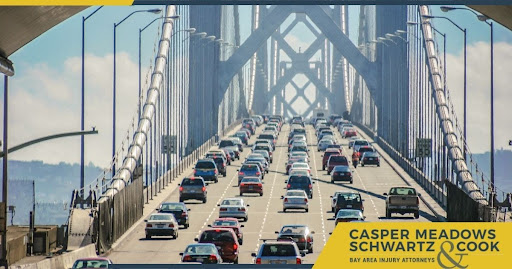If you find yourself stuck in California’s notorious highway traffic, you’re not alone. Every day, thousands of drivers experience slowdowns on I-5, the 101, or one of the Bay Area’s many congested roadways. While we can’t always avoid traffic, we can take steps to avoid making it worse—and more dangerous. The way we drive plays a significant role in both congestion and accidents. Small choices, such as staying alert, avoiding sudden movements, and giving others space, can make a big difference.
At Casper, Meadows, Schwartz & Cook, we help crash victims every day, and we know how important safe driving habits really are.
Stay in Your Lane
One of the biggest causes of slowdowns is unnecessary lane changing. When you see a lane moving faster than yours, it’s tempting to hop over. But every lane change forces drivers around you to brake or shift positions, which slows traffic overall. When enough drivers do this, it causes the entire flow to stall. Even if it feels like the left lane is moving faster, staying in your lane is often the more efficient and safer choice.
Excessive lane switching also increases the chance of sideswipe collisions. If someone else doesn’t see you or you misjudge their speed, it can result in a serious crash. By staying put and staying calm, you help traffic move more smoothly and protect yourself and others from harm.
Drive Smoothly and Be Patient
Traffic isn’t just about volume—it’s also about rhythm. Sudden stops and fast acceleration cause a ripple effect that backs up traffic for miles. If one driver brakes hard, the car behind them does too, and so on. This stop-and-go chain reaction turns a manageable slowdown into a frustrating jam.
Instead, keep a steady pace when possible. Let your car roll forward with the flow rather than rushing ahead only to hit the brakes. Even if it means getting there a few minutes later, you’ll help everyone else behind you keep moving.
This approach also helps prevent rear-end accidents. These are among the most common crashes on California highways, especially in heavy traffic. By maintaining a smooth and predictable driving pattern, you reduce your chances of being involved in one.
Keep a Safe Distance
Tailgating doesn’t save time—it just creates stress and increases the risk of a crash. Aim to leave at least two to three seconds of space between you and the vehicle ahead. This gives you enough time to respond if traffic suddenly slows down.
Following too closely is especially dangerous at high speeds or in poor weather. If the car in front of you hits the brakes, you may not be able to stop in time. It’s not just about your reaction time; it’s about physics. More space means more time to stop, which means fewer crashes and smoother driving for everyone.
Avoid Distractions and Aggression
Distracted driving is one of the leading causes of accidents in California. Phones, food, in-car entertainment, and even daydreaming can take your eyes off the road long enough to cause a crash. Stay focused, especially in traffic. Conditions change quickly, and a brief distraction can lead to a chain-reaction collision.
Aggressive driving is another hazard. Swerving, honking, and blocking others out of frustration doesn’t solve anything. If someone needs to merge or change lanes, let them. Trying to prevent them could lead to a fender bender or worse.
Driving with a calm and cooperative mindset helps everyone. A little patience goes a long way when you’re sharing the road with thousands of other people trying to get home safely.
Drive Like Everyone’s Watching
When you’re behind the wheel, every decision matters. We all share California’s roads, and the way we drive affects more than just our own commute. By staying alert, avoiding distractions, and giving others space, you can help reduce both congestion and accidents.
If you’ve been hurt in a highway crash caused by someone else’s reckless driving, contact our team at Casper, Meadows, Schwartz & Cook. We can help you understand your options and fight for fair compensation.

